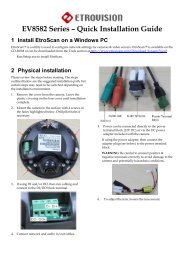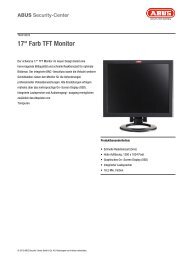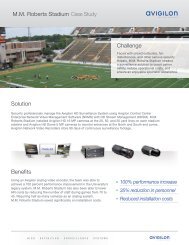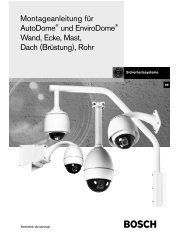EV8581 Series â Quick Installation Guide
EV8581 Series â Quick Installation Guide
EV8581 Series â Quick Installation Guide
You also want an ePaper? Increase the reach of your titles
YUMPU automatically turns print PDFs into web optimized ePapers that Google loves.
<strong>EV8581</strong> <strong>Series</strong> – <strong>Quick</strong> <strong>Installation</strong> <strong>Guide</strong><br />
1 Install EtroScan on a Windows PC<br />
EtroScan is a utility is used to configure network settings for cameras & video servers. EtroScan is available on the<br />
CD-ROM or can be downloaded from the Tools section at http://www.etrovision.com/Download_list.aspx?no=5.<br />
Run Setup.exe to install EtroScan.<br />
2 Camera Interior<br />
8. Adjust the camera lens using tilt & swivel controls<br />
as needed (refer to sections 4 & 5 for viewing<br />
video)<br />
12. Tighten the screws to fix dome cover<br />
4 <strong>EV8581</strong>U-B<br />
The <strong>EV8581</strong>U-B doesn’t have a vari-focal lens, but has<br />
a fixed lens which can be adjusted by loosening the<br />
lock screw and turning the lens.<br />
9. Adjust focus and zoom as necessary<br />
10. If dome fogging is a concern, peel and place the<br />
silica gel packet on the inside of the dome.<br />
5 BNC Connector<br />
The camera can provide video out via BNC cable. The<br />
BNC cable provided has a 2 pin plug. When<br />
connecting the BNC cable for SDTV video out, connect<br />
the BNC cable to pin 3 & 4 as shown below.<br />
The TV Output also needs to be enabled in the web UI<br />
Video Settings page. See the Users Manual for more<br />
information.<br />
3 Basic Physical<br />
installation<br />
It is recommended leaving the plastic dome covering<br />
on until camera installation is complete.<br />
1. Unscrew the screws securing the dome, and pull<br />
off dome cover.<br />
3. Insert power connector cables into the camera’s<br />
power input port. The middle port is the positive<br />
input; the negative will depend on DC or AC<br />
(refer to label inside the camera).<br />
2. Drill 3 pilot holes and insert anchors. Use screws<br />
to affix the camera base to the ceiling or wall.<br />
4. Insert Micro SD card (if applicable)<br />
5. Using the label on the digital I/O terminal,<br />
connect the digital I/O (if applicable)<br />
6. Insert Ethernet cable<br />
7. Connect power; there is no power button,<br />
recycling power restarts the camera. Power can<br />
also be provided via PoE (not available in<br />
<strong>EV8581</strong>U-B).<br />
11. Place the dome cover on the camera; take care that<br />
dome cover seal remains intact<br />
6 Configure the Network Settings<br />
The factory default IP address settings:<br />
IP Address 192.168.1.2<br />
Subnet Mask 255.255.255.0<br />
Gateway 192.168.1.1<br />
Run EtroScan (program available via Start -> All Programs -> Etrovision Technology menu)
7 Access IP Camera Web<br />
Interface<br />
When accessing an IP camera using the web interface<br />
for the first time (or when the IP address changes),<br />
some configuration for ActiveX controls are required.<br />
1. Open an IE browser<br />
2. Type in the IP address in the URL:<br />
http:// (e.g.<br />
http://10.1.21.53)<br />
Pop-up windows and messages for download/run<br />
Active X controls (examples below) will likely be<br />
displayed. Select Install or Run to all such messages.<br />
8 Restoring Factory Default<br />
Settings<br />
There are 2 methods for restoring the factory default<br />
settings:<br />
1. Power on the camera, push and hold down the<br />
reset button for 6 seconds. The camera will revert<br />
to factory default settings (e.g. IP will reset to<br />
192.168.1.2).<br />
2. The web UI Setup (System -> Factory Default) ;<br />
network and user account data can be saved if<br />
desired. Please refer to the User’s Manual for more<br />
information on the web UI Factory Default<br />
functionality.<br />
Click on the add-on message, and choose Run Add-on<br />
Repeat the above until all ActiveX controls have been<br />
initiated. Once the process is complete, the Live View<br />
will be displayed in IE.



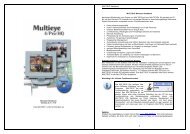

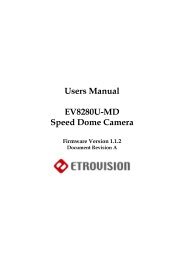
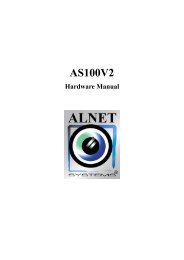
![Cover [IP8161]_Outline.ai](https://img.yumpu.com/39386743/1/185x260/cover-ip8161-outlineai.jpg?quality=85)
